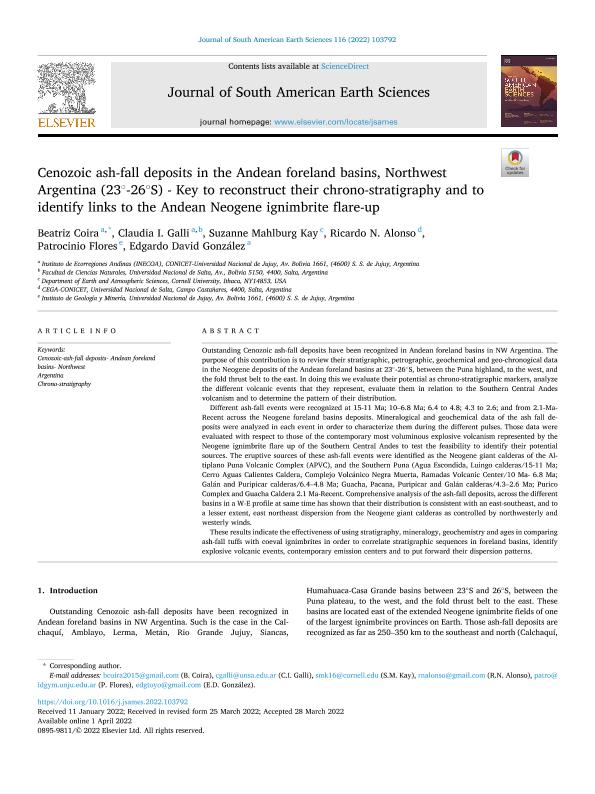Artículo
Cenozoic ash-fall deposits in the Andean foreland basins, Northwest Argentina (23°-26°S) - Key to reconstruct their chrono-stratigraphy and to identify links to the Andean Neogene ignimbrite flare-up
Coira, Beatriz Lidia Luisa ; Galli, Claudia Inés
; Galli, Claudia Inés ; Mahlburg Kay, Suzanne; Alonso, Ricardo Narciso
; Mahlburg Kay, Suzanne; Alonso, Ricardo Narciso ; Flores, Patrocinio Ismael; Gonzalez, Edgar David
; Flores, Patrocinio Ismael; Gonzalez, Edgar David
 ; Galli, Claudia Inés
; Galli, Claudia Inés ; Mahlburg Kay, Suzanne; Alonso, Ricardo Narciso
; Mahlburg Kay, Suzanne; Alonso, Ricardo Narciso ; Flores, Patrocinio Ismael; Gonzalez, Edgar David
; Flores, Patrocinio Ismael; Gonzalez, Edgar David
Fecha de publicación:
06/2022
Editorial:
Pergamon-Elsevier Science Ltd
Revista:
Journal of South American Earth Sciences
ISSN:
0895-9811
Idioma:
Inglés
Tipo de recurso:
Artículo publicado
Clasificación temática:
Resumen
Outstanding Cenozoic ash-fall deposits have been recognized in Andean foreland basins in NW Argentina. The purpose of this contribution is to review their stratigraphic, petrographic, geochemical and geo-chronogical data in the Neogene deposits of the Andean foreland basins at 23°-26°S, between the Puna highland, to the west, and the fold thrust belt to the east. In doing this we evaluate their potential as chrono-stratigraphic markers, analyze the different volcanic events that they represent, evaluate them in relation to the Southern Central Andes volcanism and to determine the pattern of their distribution. Different ash-fall events were recognized at 15-11 Ma; 10–6.8 Ma; 6.4 to 4.8; 4.3 to 2.6; and from 2.1-Ma-Recent across the Neogene foreland basins deposits. Mineralogical and geochemical data of the ash fall deposits were analyzed in each event in order to characterize them during the different pulses. Those data were evaluated with respect to those of the contemporary most voluminous explosive volcanism represented by the Neogene ignimbrite flare up of the Southern Central Andes to test the feasibility to identify their potential sources. The eruptive sources of these ash-fall events were identified as the Neogene giant calderas of the Altiplano Puna Volcanic Complex (APVC), and the Southern Puna (Agua Escondida, Luingo calderas/15-11 Ma; Cerro Aguas Calientes Caldera, Complejo Volcánico Negra Muerta, Ramadas Volcanic Center/10 Ma- 6.8 Ma; Galán and Puripicar calderas/6.4–4.8 Ma; Guacha, Pacana, Puripicar and Galán calderas/4.3–2.6 Ma; Purico Complex and Guacha Caldera 2.1 Ma-Recent. Comprehensive analysis of the ash-fall deposits, across the different basins in a W-E profile at same time has shown that their distribution is consistent with an east-southeast, and to a lesser extent, east northeast dispersion from the Neogene giant calderas as controlled by northwesterly and westerly winds. These results indicate the effectiveness of using stratigraphy, mineralogy, geochemistry and ages in comparing ash-fall tuffs with coeval ignimbrites in order to correlate stratigraphic sequences in foreland basins, identify explosive volcanic events, contemporary emission centers and to put forward their dispersion patterns.
Archivos asociados
Licencia
Identificadores
Colecciones
Articulos(INECOA)
Articulos de INSTITUTO DE ECORREGIONES ANDINAS
Articulos de INSTITUTO DE ECORREGIONES ANDINAS
Citación
Coira, Beatriz Lidia Luisa; Galli, Claudia Inés; Mahlburg Kay, Suzanne; Alonso, Ricardo Narciso; Flores, Patrocinio Ismael; et al.; Cenozoic ash-fall deposits in the Andean foreland basins, Northwest Argentina (23°-26°S) - Key to reconstruct their chrono-stratigraphy and to identify links to the Andean Neogene ignimbrite flare-up; Pergamon-Elsevier Science Ltd; Journal of South American Earth Sciences; 116; 6-2022; 1-18
Compartir
Altmétricas



